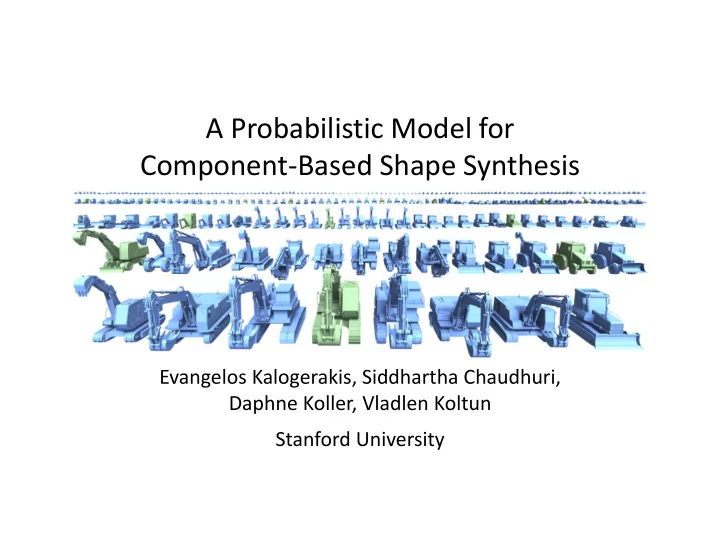

A Probabilistic Model for Component ‐ Based Shape Synthesis Evangelos Kalogerakis, Siddhartha Chaudhuri, Daphne Koller, Vladlen Koltun Stanford University
Goal: generative model of shape
Goal: generative model of shape
Challenge: understand shape variability • Structural variability • Geometric variability • Stylistic variability Our chair dataset
Related work: variability in human body and face • A morphable model for the synthesis of 3D faces [Blanz & Vetter 99] • The space of human body shapes [Allen et al. 03] • Shape completion and animation of people [Anguelov et al. 05] [Allen et al. 03] Scanned bodies
Related work: probabilistic reasoning for assembly ‐ based modeling [Chaudhuri et al. 2011] Inference Probabilistic model Modeling interface
Related work: probabilistic reasoning for assembly ‐ based modeling
Randomly shuffling components of the same category
Our probabilistic model • Synthesizes plausible and complete shapes automatically
Our probabilistic model • Synthesizes plausible and complete shapes automatically • Represents shape variability at hierarchical levels of abstraction
Our probabilistic model • Synthesizes plausible and complete shapes automatically • Represents shape variability at hierarchical levels of abstraction • Understands latent causes of structural and geometric variability
Our probabilistic model • Synthesizes plausible and complete shapes automatically • Represents shape variability at hierarchical levels of abstraction • Understands latent causes of structural and geometric variability • Learned without supervision from a set of segmented shapes
Learning stage
Synthesis stage
Learning shape variability We model attributes related to shape structure: Shape type Component types Number of components Component geometry P( R, S , N , G )
R P( R )
R P( R )
R N l L Π [ P( N l | R ) ] P( R ) l ∈ L
R N l S l L Π [ P( N l | R ) P ( S l | R ) ] P( R ) l ∈ L
R N l S l L Π [ P( N l | R ) P ( S l | R ) ] P( R ) l ∈ L
R N l S l D l C l L Π [ P( N l | R ) P ( S l | R ) P( D l | S l ) P( C l | S l ) ] P( R ) l ∈ L
R N l S l Width D l C l L Height Π [ P( N l | R ) P ( S l | R ) P( D l | S l ) P( C l | S l ) ] P( R ) l ∈ L
R Latent object style N l S l Latent component style D l C l L Π [ P( N l | R ) P ( S l | R ) P( D l | S l ) P( C l | S l ) ] P( R ) l ∈ L
R N l S l Learn from training data: D l C l latent styles lateral edges L parameters of CPDs
Learning Given observed data O , find structure G that maximizes:
Learning Given observed data O , find structure G that maximizes:
Learning Given observed data O , find structure G that maximizes:
Learning Given observed data O , find structure G that maximizes:
Learning Given observed data O , find structure G that maximizes: Assuming uniform prior over structures, maximize marginal likelihood : �
Learning Given observed data O , find structure G that maximizes: Assuming uniform prior over structures, maximize marginal likelihood : � Complete likelihood
Learning Given observed data O , find structure G that maximizes: Assuming uniform prior over structures, maximize marginal likelihood : � Parameter priors
Learning Given observed data O , find structure G that maximizes: Assuming uniform prior over structures, maximize marginal likelihood : �
Learning Given observed data O , find structure G that maximizes: Assuming uniform prior over structures, maximize marginal likelihood : � Cheeseman ‐ Stutz approximation
Our probabilistic model: synthesis stage
Shape Synthesis Enumerate high ‐ probability instantiations of the model {} {R=1} {R=2} {R=1,S 1 =1} {R=1,S 1 =2} {R=2,S 1 =2} {R=2,S 1 =2} …
Component placement Unoptimized Optimized Source new shape new shape shapes
Database Amplification ‐ Airplanes
Database Amplification ‐ Airplanes
Database Amplification ‐ Chairs
Database Amplification ‐ Chairs
Database Amplification ‐ Ships
Database Amplification ‐ Ships
Database Amplification ‐ Animals
Database Amplification ‐ Animals
Database Amplification – Construction vehicles
Database Amplification – Construction vehicles
Interactive Shape Synthesis
User Survey Synthesized Training shapes shapes
Results Source shapes New shape (colored parts are selected for the new shape)
Results Source shapes New shape (colored parts are selected for the new shape)
Results of alternative models: no latent variables R N 1 S 1 S 2 N 2 C 2 D 2 C 1 D 1
Results of alternative models: no part correlations R N 1 S 1 S 2 N 2 C 2 D 2 C 1 D 1
Summary • Generative model of component ‐ based shape synthesis • Automatically synthesizes new shapes from a domain demonstrated by a set of example shapes • Enables shape database amplification or interactive synthesis with high ‐ level user constraints
Future Work • Our model can be used as a shape prior ‐ applications to reconstruction and interactive modeling • Synthesis of shapes with new geometry for parts • Model locations and spatial relationships of parts
Thank you! Acknowledgements: Aaron Hertzmann, Sergey Levine, Philipp Krähenbühl, Tom Funkhouser Our project web page: http://graphics.stanford.edu/~kalo/papers/ShapeSynthesis/
Recommend
More recommend